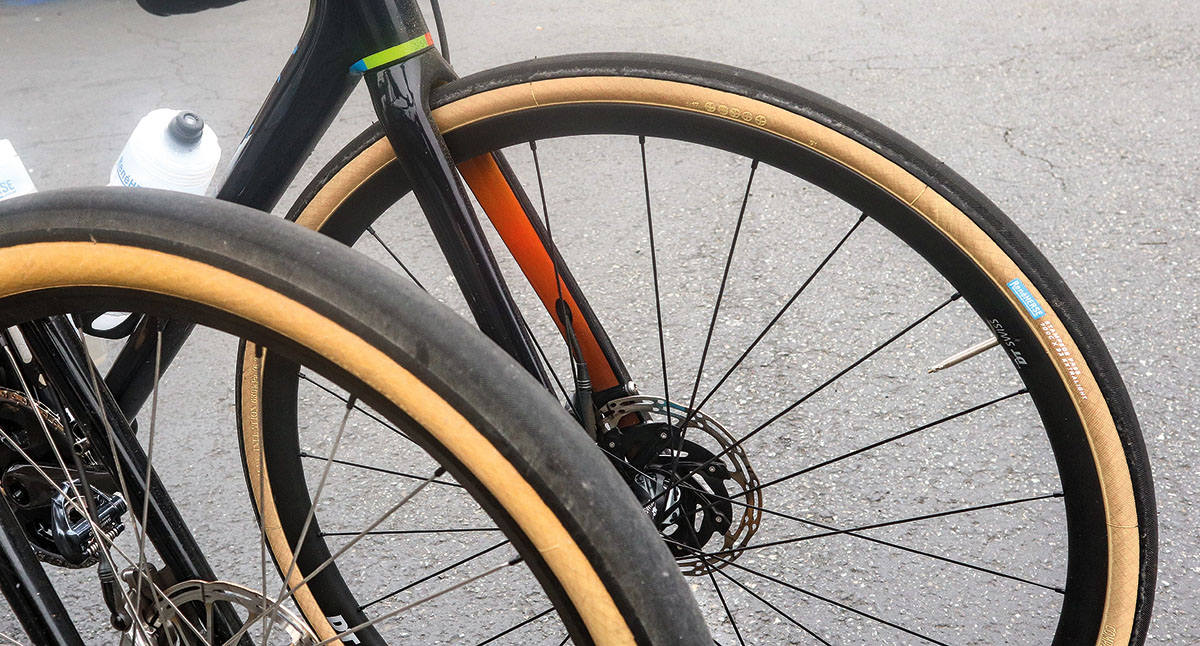Why wider tires are NOT slower
Our bike shop partners tell us that the most asked question these days is: “Aren’t wide tires slower than narrow tires?” That’s what all of us believed for many decades, and old beliefs don’t disappear overnight.
Most of us agree that wide tires can make cycling much more fun, because they encourage us to seek out less-traveled roads. Roads that tend to be also less-maintained (and bumpier), too. Wide tires are safer, too, because they have more grip and because they don’t easily fall into cracks in the pavement. But aren’t they slower? Nobody wants to struggle while trying to keep up with their riding buddies. The effortless feeling of gliding along is what makes cycling so special. Fortunately, we don’t need to give that up when we go to wider tires.
Science
The only meaningful way to test the performance of tires is with a rider on the bike. Lab tests on steel drums don’t measure the most important component – the suspension losses caused by vibrations of the bike and rider.
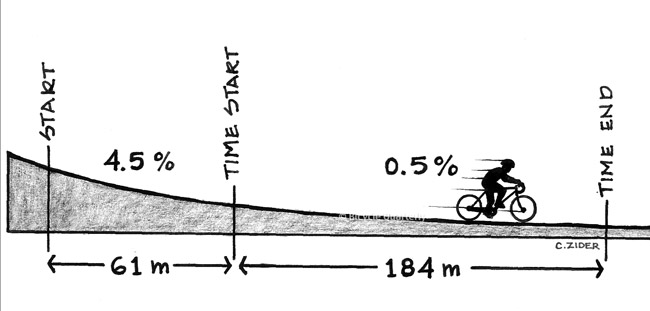
To test tires on real roads, we coast down a hill with constant speed. We need to pick a day with no wind, and we need to do many runs to make sure we aren’t just seeing small changes in rider position, air currents and other ‘noise.’
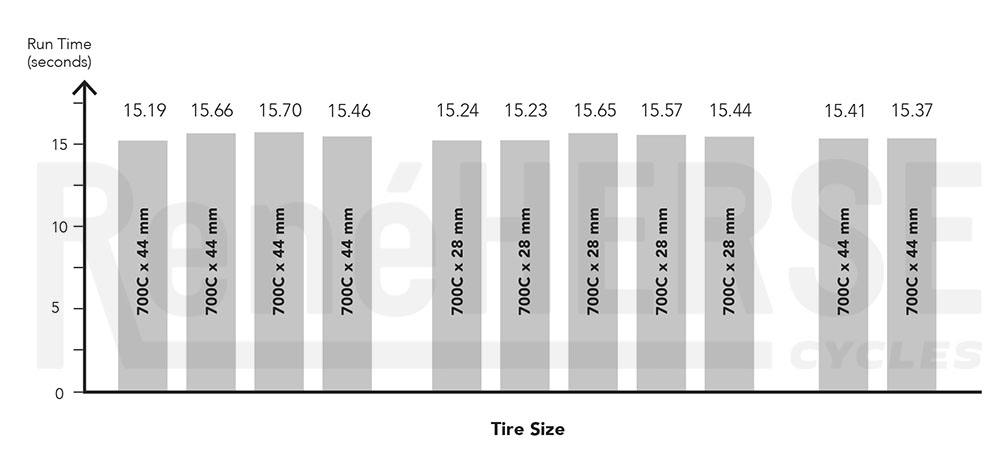
We started doing these tests in 2006 – back when go-fast tires were 23 mm wide. We’ve tested literally hundreds of times, with different tires, different pressures, on different days, even with different riders. A single test is good, but you’ll want to confirm your results many times to be sure. Above are some of our latest results, with Rene Herse Extralight tires. We ran a 44 mm tire four times, then a 28 mm tire five times, before running the 44 mm tire again. (Running the first tire again makes sure that conditions haven’t changed during our test runs.) Translating the times above into the average speed for each tire, we get:
28 mm: 27.636 km/h
44 mm: 27.564 km/h
That difference is less than 0.3%. It’s not statistically significant – meaning that we cannot say whether this is a real difference or just ‘noise’ in the data. If we ran these tests again, the 44 mm tire might come out ahead. Either way, the difference is too small to notice on the road. In other words, you won’t get dropped if your friends are on 28s and you are on 44s.
Tire pressure
In the test above, we ran the 44 mm tires at 2.1 bar (30 psi); the 28 mm tires at 4.5 bar (65 psi). Even though the wider tires were inflated to less than half the pressure – much more comfortable! – they rolled at the same speed. In the links at the end of the article, you’ll find resources that explain why high tire pressure doesn’t make a bike faster. You won’t get dropped if you inflate your tires to a more comfortable pressure, rather than the max. written on the sidewall.
What about aerodynamics?
The tests above were done at moderately high speeds. (27.6 km/h translates into 17.1 mph.) What we’re measuring is the bike speed with the wide and narrow tires, so the aerodynamics are already factored in. Our testing shows that wider tires aren’t significantly less aero than narrow ones. That makes sense: The frontal area of a 44 mm tire isn’t much larger than a 28 mm tire. (If a few millimeters made a huge difference, modern carbon bikes with wide down tubes would be slow.)
The tests above were done with a modern carbon bike (Salsa Warbird) and Enve 45 aero wheels. So we can say that for the purposes of real rides on real roads, wide tires aren’t less aero than narrow ones.
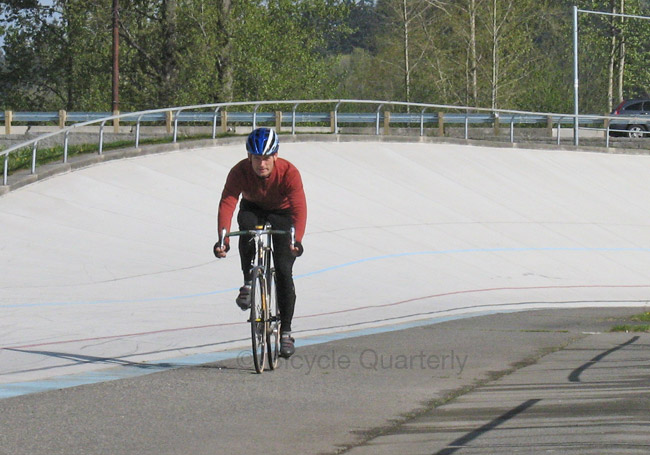
Track Tests
To replicate our tests with a different methodology, we measured tire performance on a track with power meters. We tested on the inside of our local velodrome, where it’s paved with asphalt. (The actual velodrome surface is smooth concrete that isn’t representative of the road surfaces where we usually ride.) In our previous tests, we coasted. In the track tests, we pedaled. This allowed us to verify that the pedaling motion doesn’t somehow affect the results. For example, moving our legs up and down might compress wider (and softer) tires more with each pedal stroke. This time, we tested at 29.5 km/h (18.3 mph) and measured the power it took to pedal the bike.
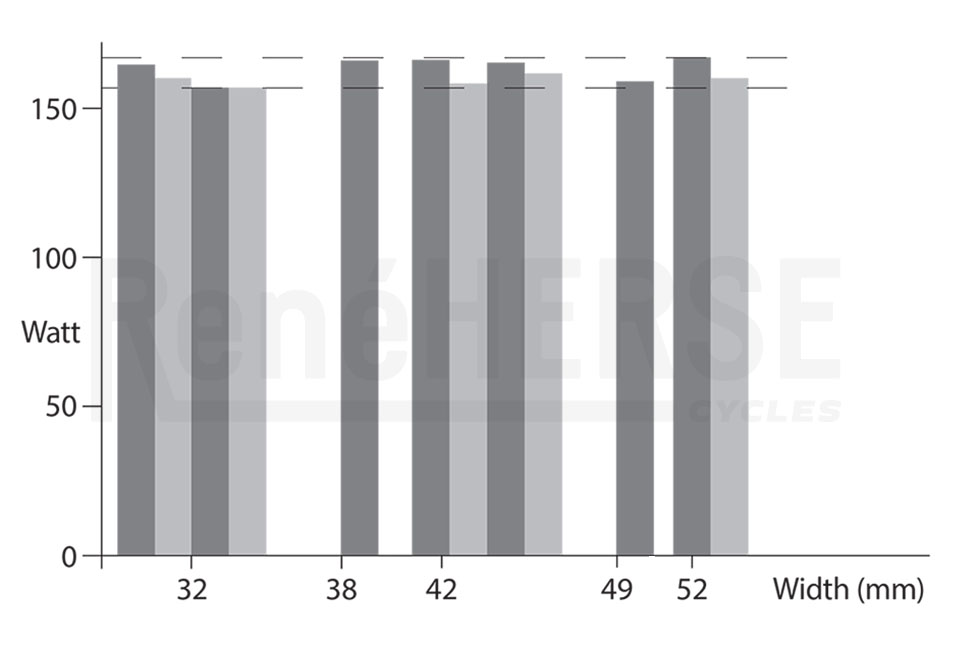
The results confirmed once more: Wide tires don’t require more power. We tested tires between 26 and 54 mm – all with the same casings and tread to make them comparable. (We used Rene Herse Extralights for this test.) When the rider pedals, there’s a little more noise in the data, but there is nothing that would suggest that wider tires are slower. In fact, the widest tires were among the fastest. The narrowest tires were among the slowest. The differences are very small – it’s just inevitable ‘noise’ in the data when you have a rider pedaling. Based on these and many other tests, we can say:
Wide tires aren’t slower.
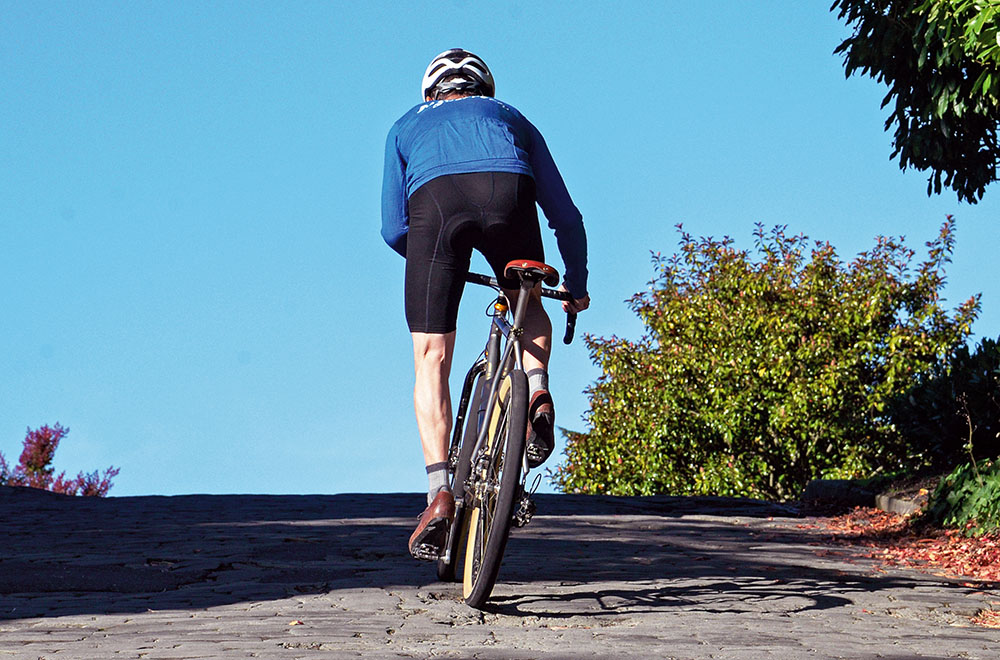
Smooth vs rough roads
All the tests above were on smooth roads. Smooth asphalt is the best-case scenario for narrow tires. We’ve also tested on rough roads, and we found that wider tires are faster. The results don’t come as a surprise: The rougher the surface, the better wide tires perform. On really rough roads, wide tires can save significant energy, because they reduce the vibrations that cause suspension losses and slow us down.
Actually, what makes wide tires faster on rough surfaces is the lower tire pressure. Soft tires can absorb surface irregularities without lifting bike and rider. Wider tires can run at lower pressures without bottoming out – that’s why they are faster on rough ground.
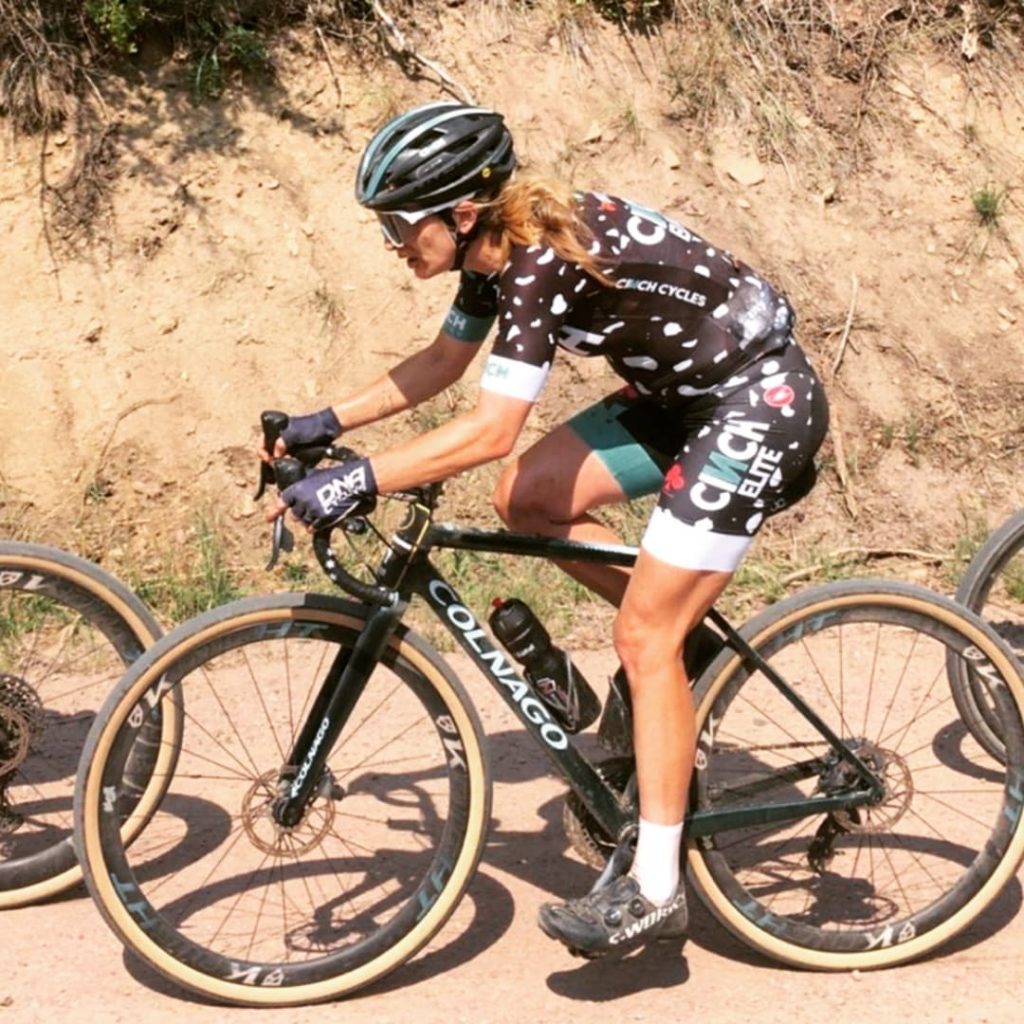
Real-World Performance
Theory and tests are one thing, but what matters is performance in the real world. We’ve been working with some of the best racers, and they’ve racked up wins and podium placings on wide Rene Herse tires. Lauren de Crescenzo started riding our 44 mm-wide Snoqualmie Pass Extralights mid-way through the last season, and she reported: “Extralights are so fast!!!”
Lauren went on to win SBT GRVL, Gravel Worlds, Mid-South and a host of other races. In The Rad Dirt, she almost beat the men, too, coming second overall. Most of that is due to Lauren’s legs, of course, but she also ran wider tires than most of the guys, even though she’s one of the lightest riders in the peloton. Not only were the wide tires faster on the gravel, but they’re also less flat-prone because they run at lower pressures. And that means Lauren could race on the ultra-supple Extralight casings, which provided additional speed. (She’d probably prefer if we didn’t talk about this. As long as many of the other racers are on 35 mm tires, she’s got an additional advantage.)
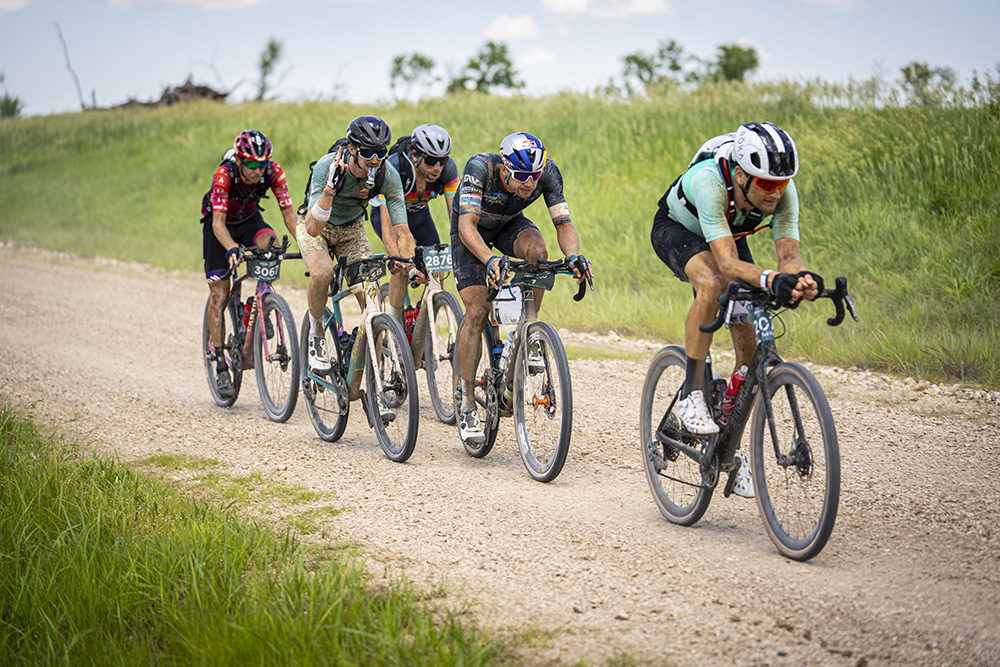
Ted King (above on the right) ran 44 mm Rene Herse tires in Unbound, the epic 200-mile gravel race in the Flint Hills of Kansas. He was recovering from breaking his collarbone just five weeks before the race, yet he placed 4th against a Who-is-Who of professional racers. And now he has a new bike with more clearance – he might go wider yet.
What about lab tests?
On web sites like www.bicyclerollingresistance.com, the 20 fastest tires are all narrow racing tires. Doesn’t that show that narrower tires are faster? Not really: These tests are performed on a drum, without a rider. Testing that way can’t measure the suspension losses that are caused by vibrations of bike and rider. Just consider this: Tests on steel drums show that higher pressures are faster, but we all know that isn’t the case. Even pro racers no longer inflate their tires to 120 psi (8 bar), because that actually makes the slower. If these drum tests were representative of real-world conditions, the pros would still ride 20 mm tires, since only narrow tires can handle the highest pressures. But they don’t: Today’s racers are on 25s or 28s, because they roll faster on real roads.
Testing on steel drums is an outdated method that few people use any longer. It’s like testing a bike’s speed on downhills only – a heavier bike will be faster, but you’re overlooking the most important part of any race or ride – the uphills. Or in the case of tire resistance, you’re overlooking the suspension losses caused by vibrations. Understanding and measuring suspension losses is the basis for the ‘All-Road Bike Revolution’ that has completely changed what we consider a performance bike.
Placebo effect: Narrow tires feel faster
Here’s one reason why cyclists have believed for so long that narrow tires roll faster. They feel faster, even if they aren’t. Here’s why: The faster we ride, the higher the frequency at which our bike vibrates, because our tires encounter road irregularities in quicker succession. So we’ve been conditioned to equate high-frequency vibrations with speed. When we switch to wide tires, the lower pressure filters out most vibrations. That means the bike feels slower at first, until we ride with friends and realize that we have no trouble keeping up.
This placebo effect of narrow tires – they create more vibrations, which gives us the sensation of going faster – is probably one reason why some riders are slow to accept that wide tires can roll as fast as narrow ones. Racers like Lauren and Ted test their equipment with power meters and not by feel alone. They’ve confirmed that in the real world, wide tires aren’t any slower on smooth roads. And when the going gets rough, wide tires are faster.
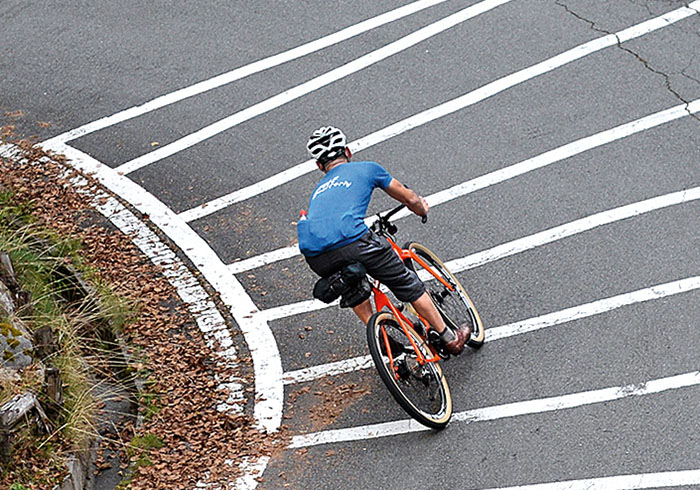
Cornering grip
The discussion of wide vs narrow tires wouldn’t be complete without mentioning cornering grip. If you want to go fast on twisty descents, wider tires provide much more grip. It’s not just that they have more rubber on the road, they also don’t skip when they hit bumps. Keeping more rubber on the road surface at all times means more cornering grip. It’s as simple as that. (You’ve probably noticed that race cars and fast motorbikes have very wide tires.)
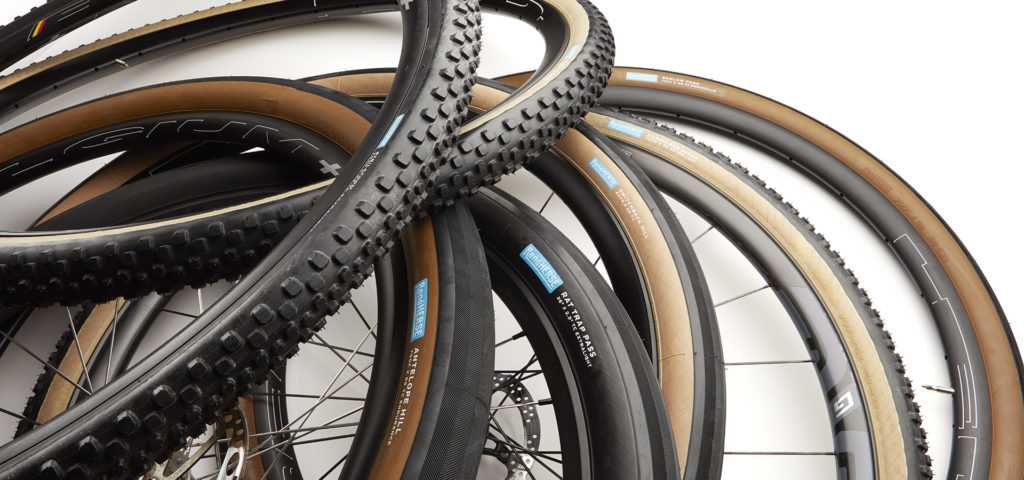
What Makes a Tire Fast?
If wider tires are neither slower nor faster – at least on smooth roads – does that mean that all tires roll at the same speed? It’s not that simple.
In fact, many wide tires are slow. That’s not because they are wide, but they use heavy reinforced casings that were developed for touring tires. Casing performance determines 95% of a tire’s speed. For good performance, you need a supple high-performance casing. That’s why we’ve developed our Rene Herse tires – to combine the speed of racing tires with the comfort and go-anywhere capabilities of wide tires. Afraid of punctures and sidewall cuts? Rene Herse Endurance and Endurance Plus tires are stronger than most ‘gravel’ and ‘touring’ tires without giving much speed. We use a dense weave and sophisticated puncture protection technology together with high-end, supple casings to create ultra-tough tires that roll faster than many ‘racing’ tires.
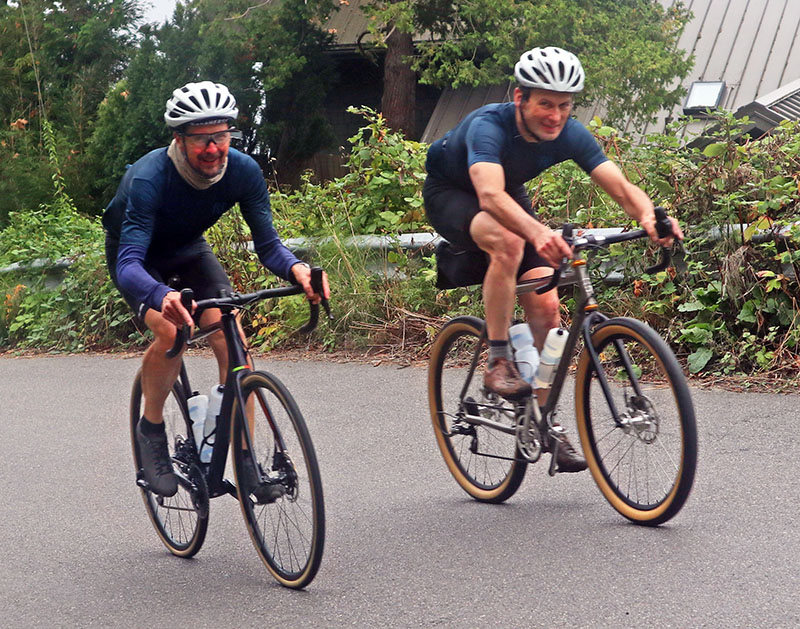
Conclusion
Whether it’s carefully controlled tests or real-world race results, the verdict is in: Wide tires are not slower than narrow tires. This means you can enjoy comfort and rough-road fun without giving up speed on smooth pavement. Just make sure you choose tires with supple high-performance casings. Stiff tires are slow, no matter how wide they are.
There’s nothing wrong with narrow tires, of course. If you prefer the ‘connected-to-the-road’ feel of a racing bike, then you’ll be happier on narrow tires. If your friends tease you to get ‘with the program,’ remind them: narrow tires are not slower than wide tires – they just aren’t faster, either. Even on racing bikes, most of us have been going to wider tires – 28 or 32 mm is now the standard. And if your friends show up at the next ride on 44s, don’t be fooled into thinking that you can drop them because their wider tires look slow.
Further Reading:
- How the All-Road Revolution has changed our understanding of how tires and pressure really work.
- Why tests on steel drums don’t measure tire performance correctly.
- Why higher pressures don’t make your bike faster.
- What makes a bike fast?
- Our book ‘The All-Road Bike Revolution’ goes into more detail why wide tires can be fast, how to find a frame that optimizes your power output, how to get a bike that handles like an extension of your body, and many other topics.


